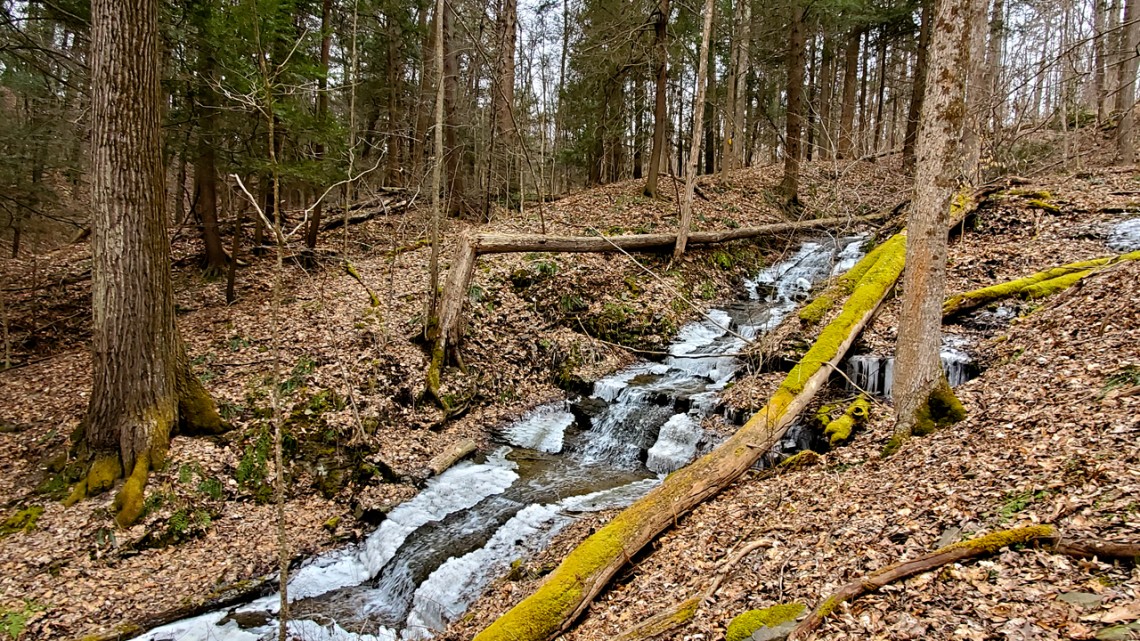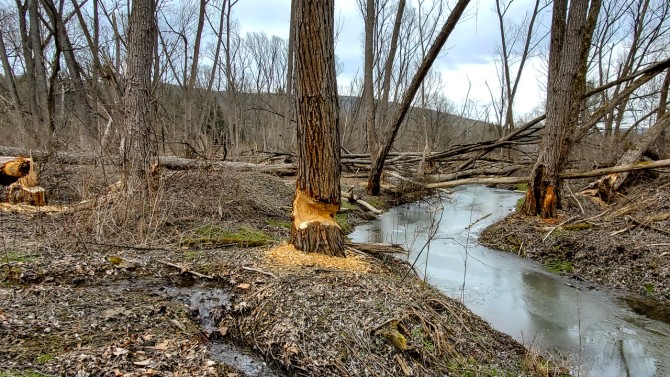
The Fischer Old-growth Forest natural area in Newfield, New York, is home to a number of uncommon birds, amphibians, insects and plants.
Old-growth forest preserve gains acreage through local partnership
By Laura Gallup, Cornell Chronicle
Cornell Botanic Gardens has acquired 81 acres adjacent to the Fischer Old-growth Forest natural area in Newfield, New York, to further protect some of the county’s most mature trees – some of them 300 years old.
The addition, finalized in March and made possible through a partnership between the university and the donor of the parcel, Shamrock Communities, LLC – as well as Finger Lakes Land Trust (FLLT) and Tompkins County – is an unusual arrangement for Cornell.
The Botanic Gardens secured grant money from the county’s Natural Infrastructure Capital Program to cover closing costs and initial property maintenance. To be eligible for the grant, the land needed to be permanently protected. This protection will be provided through a conservation easement with FLLT, which will protect the land in perpetuity from future development.
“Land conservation rarely happens without strong partnerships,” said Todd Bittner, the director of natural areas for Cornell Botanic Gardens. “We are fortunate to have committed conservation partners that are willing to find novel solutions that ensure our collective natural heritage is conserved."
Fischer Old-growth Forest is one of the best examples of European pre-settlement forests in the region; researchers believe the old-growth forest has never been farmed or logged. It is the only forest in the county with trees taller than 150 feet, and is home to at least 23 canopy tree species.
“The thing that really identifies an old-growth forest is the large dead trees that have fallen. If they had been logged, they wouldn't be there to die and fall,” Bittner said.
The natural area now totals 181 acres. Bittner said that although the conservation easement is still pending, a trail has already been expanded and rerouted through the addition and is open to the public.
Access to the preserve starts in a small parking area across from a business at 1346 Elmira Road, and includes 2.1 miles of trails. The forest contains a number of uncommon birds, amphibians, insects and plants, including the locally rare yellow oak (Quercus muehlenbergii).
The original 31.2-acre forest was acquired by the university in 1997 after decades of negotiations with the Cotton-Hanlon Lumber Company of Alpine, New York, saving the ancient trees from being felled.
“The trees were inventoried, they were marked for harvest,” Bittner said of the forest’s original fate. “And Cornell faculty became aware of that, and the university lobbied Cotton-Hanlon to find some mutual arrangement that would protect the forest and meet Cotton-Hanlon’s needs, and ultimately landed on a land trade for another Cornell forest that was less sensitive.”
In 1998 the forest was named to honor Richard B. Fischer, a beloved Cornell professor of environmental education, for his delight in natural history and his passion for environmental protection, which he passed on to his many students. Fischer died in 2005.
Cornell purchased an adjoining 10 acres in 2000 to create a buffer around the forest. David Bandler, emeritus professor of food science in the College of Agriculture and Life Sciences (CALS), and his wife Lenore donated 17.6 acres in 2015 and another 41.8 acres in 2017.
To a trained eye, a walk through this preserve can be like going back in time.
The beginning of the trail sits in a meadow near the remnants of an old barn foundation, hinting at the site's prior land use history. Further onto the property is an area of shrubs, abandoned from agricultural production 30 to 40 years ago. A young forest is just beyond, abandoned from agricultural use 50 to 70 years ago. The path eventually runs into a mature forest that had previously been timbered and concludes with the old-growth forest, home to 300-year-old trees.
“You have all the different examples of these land-use histories, and you can use them to compare and contrast and see the influence of those activities on the vegetation, on the forest types, on the habitat types,” Bittner said. “We have that whole suite now at Fischer. So it’s not just an old-growth forest – it’s a place to understand our historic and contemporary impact on the landscape.”
The natural area accommodates multiple faculty and student research projects each year on topics such as squirrel evolution, old-growth forest carbon sequestration and soil formation. It’s also a popular spot for academic field trips in classes spanning natural history, botany, wildlife, forest ecology, geology, soils, natural areas management and restoration ecology.
Anurag Agrawal, the James Perkins Professor of Environmental Studies (CALS), has taken many undergraduate classes, visitors and new faculty to the forest to showcase the high biodiversity and mature regional habitat.
“Fischer is a remarkably special place,” Agrawal said, “which makes Cornell unique as an institution with dramatic living laboratories.”
While the addition acts as a buffer around the old-growth forest, it also helps mitigate the effects of catastrophic weather events. Researchers believe this area may be the largest wetland in the Cayuga Inlet Valley, which provides flood protection for the city of Ithaca.
“We’re already experiencing increases in precipitation, both average and extreme events,” Bittner said. “Protecting existing wetlands and managing them to maintain their integrity is important not just for the ecological and academic benefits they provide, but also for flood protection. By ensuring that this 25-acre wetland will be managed as a protected natural area, it will continue to provide flood protection for everyone downstream.”
Media Contact
Abby Kozlowski
Get Cornell news delivered right to your inbox.
Subscribe


